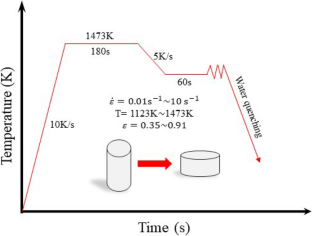Journal of Materials Science ( IF 4.5 ) Pub Date : 2024-04-21 , DOI: 10.1007/s10853-024-09649-7 Xingwang Duan , Yingqing Chen , Yue Jia , Xin Che , Jiachen Liu

|
To investigate the dynamic recrystallization (DRX) behavior of forged 42CrMoA steel during hot deformation, the hot deformation experiments of forged 42CrMoA steel under different deformation conditions (strain rate, temperature, and strain) were carried out in this paper. The hot deformation activation energy of forged 42CrMoA steel was determined to be \(413627.2\;{\text{J}}\; \cdot{\text{mol}}^{ - 1}\). The constitutive model and DRX kinetic model of the steel were established. Analyzing the reconstructed parent phase grains reveals that when the strain is constant, as the deformation temperature increases and the strain rate decreases, the average size and DRX volume fraction of the parent phase grains gradually increase, and the peak stress gradually decreases. When the deformation temperature and strain rate are constant, as the strain increases, the average size of the parent phase grains gradually decreases, and the volume fraction of DRX gradually increases. Based on the cellular automaton theory model and considering the influence of grain deformation on the DRX process, a cellular automaton dynamic recrystallization (T-DRX-CA) model for forged 42CrMoA steel based on topological deformation technology was established, and the microstructure evolution under different deformation conditions was simulated. The microstructure evolution under different deformation conditions was simulated, which was compared with experimental results. The results showed that the average errors between the simulated and experimental values of the average grain size of the parent phase, the volume fraction of DRX, and peak stress were all less than 8%, and the simulated results were in good agreement with the experimental values, which indicates that the established model can accurately predict the DRX behavior of the forged 42CrMoA steel in the process of hot deformation.
Graphical abstract
The hot deformation behavior of forged 42CrMoA steel under different deformation conditions was investigated by a cellular automaton dynamic recrystallization (T-DRX-CA) model based on topological deformation technique. The results showed that the average errors between the simulated and experimental values of the average grain size of the parent phase, the volume fraction of DRX, and peak stress were all less than 8%, and the simulated results were in good agreement with the experimental values, which indicates that the established model can accurately predict the DRX behavior of the forged 42CrMoA steel in the process of hot deformation.
中文翻译:

基于拓扑变形技术的元胞自动机方法研究锻造42CrMoA钢的热变形行为
为了研究锻造42CrMoA钢热变形过程中的动态再结晶(DRX)行为,本文对锻造42CrMoA钢在不同变形条件(应变速率、温度和应变)下进行了热变形实验。确定锻造42CrMoA钢的热变形活化能为\(413627.2\;{\text{J}}\;\cdot{\text{mol}}^{ - 1}\)。建立了该钢的本构模型和DRX动力学模型。对重构母相晶粒的分析表明,当应变一定时,随着变形温度的升高和应变速率的降低,母相晶粒的平均尺寸和DRX体积分数逐渐增大,峰值应力逐渐减小。当变形温度和应变速率一定时,随着应变的增大,母相晶粒的平均尺寸逐渐减小,DRX的体积分数逐渐增大。基于元胞自动机理论模型,考虑晶粒变形对DRX过程的影响,建立了基于拓扑变形技术的锻造42CrMoA钢元胞自动机动态再结晶(T-DRX-CA)模型,并分析了不同晶粒变形下的组织演化情况。模拟变形条件。模拟了不同变形条件下的微观组织演化,并与实验结果进行了比较。结果表明,母相平均晶粒尺寸、DRX体积分数、峰值应力的模拟值与实验值的平均误差均小于8%,模拟结果与实验结果吻合较好。值,表明所建立的模型能够准确预测锻造42CrMoA钢在热变形过程中的DRX行为。
图形概要
采用基于拓扑变形技术的元胞自动机动态再结晶(T-DRX-CA)模型研究了不同变形条件下锻造42CrMoA钢的热变形行为。结果表明,母相平均晶粒尺寸、DRX体积分数、峰值应力的模拟值与实验值的平均误差均小于8%,模拟结果与实验结果吻合较好。值,表明所建立的模型能够准确预测锻造42CrMoA钢在热变形过程中的DRX行为。



























 京公网安备 11010802027423号
京公网安备 11010802027423号